Ankush Garg
Gemini 1.5: Unlocking multimodal understanding across millions of tokens of context
Mar 08, 2024Abstract:In this report, we present the latest model of the Gemini family, Gemini 1.5 Pro, a highly compute-efficient multimodal mixture-of-experts model capable of recalling and reasoning over fine-grained information from millions of tokens of context, including multiple long documents and hours of video and audio. Gemini 1.5 Pro achieves near-perfect recall on long-context retrieval tasks across modalities, improves the state-of-the-art in long-document QA, long-video QA and long-context ASR, and matches or surpasses Gemini 1.0 Ultra's state-of-the-art performance across a broad set of benchmarks. Studying the limits of Gemini 1.5 Pro's long-context ability, we find continued improvement in next-token prediction and near-perfect retrieval (>99%) up to at least 10M tokens, a generational leap over existing models such as Claude 2.1 (200k) and GPT-4 Turbo (128k). Finally, we highlight surprising new capabilities of large language models at the frontier; when given a grammar manual for Kalamang, a language with fewer than 200 speakers worldwide, the model learns to translate English to Kalamang at a similar level to a person who learned from the same content.
Gemini: A Family of Highly Capable Multimodal Models
Dec 19, 2023Abstract:This report introduces a new family of multimodal models, Gemini, that exhibit remarkable capabilities across image, audio, video, and text understanding. The Gemini family consists of Ultra, Pro, and Nano sizes, suitable for applications ranging from complex reasoning tasks to on-device memory-constrained use-cases. Evaluation on a broad range of benchmarks shows that our most-capable Gemini Ultra model advances the state of the art in 30 of 32 of these benchmarks - notably being the first model to achieve human-expert performance on the well-studied exam benchmark MMLU, and improving the state of the art in every one of the 20 multimodal benchmarks we examined. We believe that the new capabilities of Gemini models in cross-modal reasoning and language understanding will enable a wide variety of use cases and we discuss our approach toward deploying them responsibly to users.
Order Matters in the Presence of Dataset Imbalance for Multilingual Learning
Dec 11, 2023Abstract:In this paper, we empirically study the optimization dynamics of multi-task learning, particularly focusing on those that govern a collection of tasks with significant data imbalance. We present a simple yet effective method of pre-training on high-resource tasks, followed by fine-tuning on a mixture of high/low-resource tasks. We provide a thorough empirical study and analysis of this method's benefits showing that it achieves consistent improvements relative to the performance trade-off profile of standard static weighting. We analyze under what data regimes this method is applicable and show its improvements empirically in neural machine translation (NMT) and multi-lingual language modeling.
The Devil is in the Errors: Leveraging Large Language Models for Fine-grained Machine Translation Evaluation
Aug 14, 2023Abstract:Automatic evaluation of machine translation (MT) is a critical tool driving the rapid iterative development of MT systems. While considerable progress has been made on estimating a single scalar quality score, current metrics lack the informativeness of more detailed schemes that annotate individual errors, such as Multidimensional Quality Metrics (MQM). In this paper, we help fill this gap by proposing AutoMQM, a prompting technique which leverages the reasoning and in-context learning capabilities of large language models (LLMs) and asks them to identify and categorize errors in translations. We start by evaluating recent LLMs, such as PaLM and PaLM-2, through simple score prediction prompting, and we study the impact of labeled data through in-context learning and finetuning. We then evaluate AutoMQM with PaLM-2 models, and we find that it improves performance compared to just prompting for scores (with particularly large gains for larger models) while providing interpretability through error spans that align with human annotations.
Benchmarking Neural Network Training Algorithms
Jun 12, 2023



Abstract:Training algorithms, broadly construed, are an essential part of every deep learning pipeline. Training algorithm improvements that speed up training across a wide variety of workloads (e.g., better update rules, tuning protocols, learning rate schedules, or data selection schemes) could save time, save computational resources, and lead to better, more accurate, models. Unfortunately, as a community, we are currently unable to reliably identify training algorithm improvements, or even determine the state-of-the-art training algorithm. In this work, using concrete experiments, we argue that real progress in speeding up training requires new benchmarks that resolve three basic challenges faced by empirical comparisons of training algorithms: (1) how to decide when training is complete and precisely measure training time, (2) how to handle the sensitivity of measurements to exact workload details, and (3) how to fairly compare algorithms that require hyperparameter tuning. In order to address these challenges, we introduce a new, competitive, time-to-result benchmark using multiple workloads running on fixed hardware, the AlgoPerf: Training Algorithms benchmark. Our benchmark includes a set of workload variants that make it possible to detect benchmark submissions that are more robust to workload changes than current widely-used methods. Finally, we evaluate baseline submissions constructed using various optimizers that represent current practice, as well as other optimizers that have recently received attention in the literature. These baseline results collectively demonstrate the feasibility of our benchmark, show that non-trivial gaps between methods exist, and set a provisional state-of-the-art for future benchmark submissions to try and surpass.
Binarized Neural Machine Translation
Feb 09, 2023Abstract:The rapid scaling of language models is motivating research using low-bitwidth quantization. In this work, we propose a novel binarization technique for Transformers applied to machine translation (BMT), the first of its kind. We identify and address the problem of inflated dot-product variance when using one-bit weights and activations. Specifically, BMT leverages additional LayerNorms and residual connections to improve binarization quality. Experiments on the WMT dataset show that a one-bit weight-only Transformer can achieve the same quality as a float one, while being 16x smaller in size. One-bit activations incur varying degrees of quality drop, but mitigated by the proposed architectural changes. We further conduct a scaling law study using production-scale translation datasets, which shows that one-bit weight Transformers scale and generalize well in both in-domain and out-of-domain settings. Implementation in JAX/Flax will be open sourced.
Do Current Multi-Task Optimization Methods in Deep Learning Even Help?
Sep 23, 2022

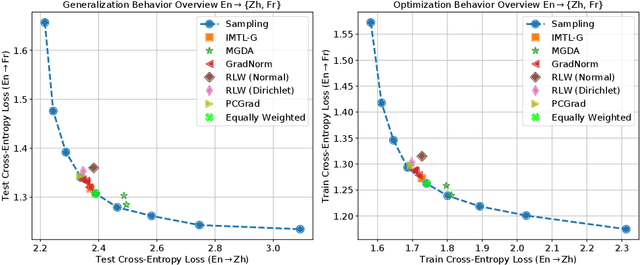

Abstract:Recent research has proposed a series of specialized optimization algorithms for deep multi-task models. It is often claimed that these multi-task optimization (MTO) methods yield solutions that are superior to the ones found by simply optimizing a weighted average of the task losses. In this paper, we perform large-scale experiments on a variety of language and vision tasks to examine the empirical validity of these claims. We show that, despite the added design and computational complexity of these algorithms, MTO methods do not yield any performance improvements beyond what is achievable via traditional optimization approaches. We highlight alternative strategies that consistently yield improvements to the performance profile and point out common training pitfalls that might cause suboptimal results. Finally, we outline challenges in reliably evaluating the performance of MTO algorithms and discuss potential solutions.
Data Scaling Laws in NMT: The Effect of Noise and Architecture
Feb 04, 2022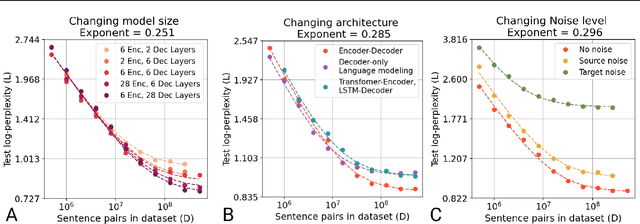


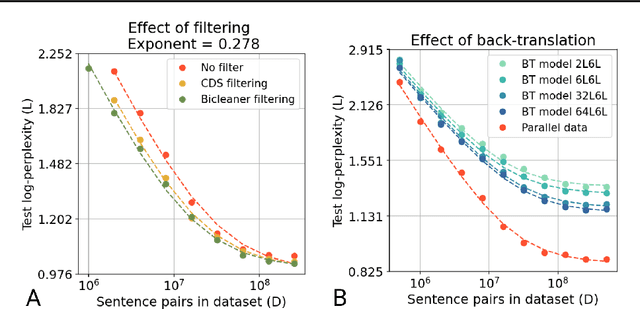
Abstract:In this work, we study the effect of varying the architecture and training data quality on the data scaling properties of Neural Machine Translation (NMT). First, we establish that the test loss of encoder-decoder transformer models scales as a power law in the number of training samples, with a dependence on the model size. Then, we systematically vary aspects of the training setup to understand how they impact the data scaling laws. In particular, we change the following (1) Architecture and task setup: We compare to a transformer-LSTM hybrid, and a decoder-only transformer with a language modeling loss (2) Noise level in the training distribution: We experiment with filtering, and adding iid synthetic noise. In all the above cases, we find that the data scaling exponents are minimally impacted, suggesting that marginally worse architectures or training data can be compensated for by adding more data. Lastly, we find that using back-translated data instead of parallel data, can significantly degrade the scaling exponent.
A Loss Curvature Perspective on Training Instability in Deep Learning
Oct 08, 2021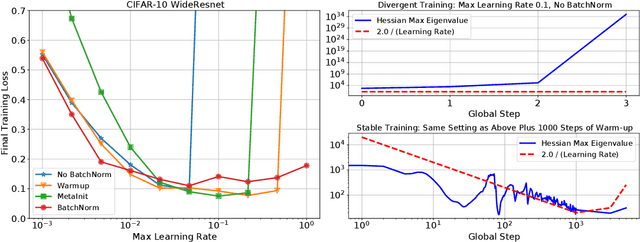

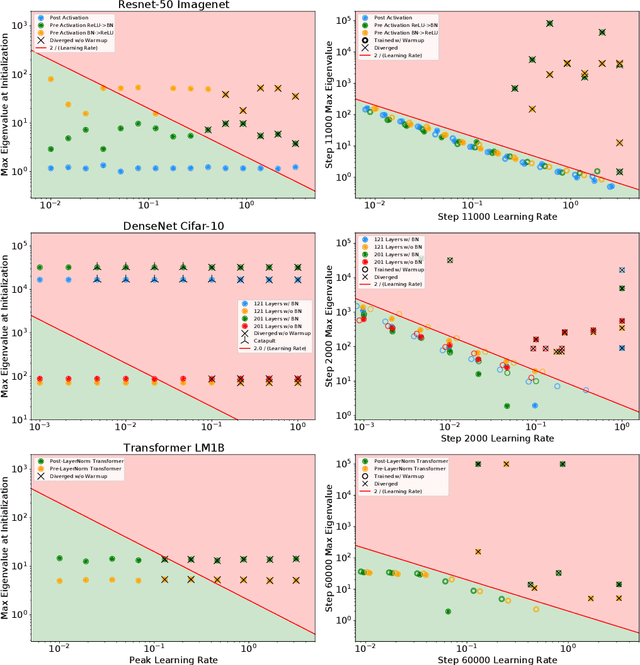

Abstract:In this work, we study the evolution of the loss Hessian across many classification tasks in order to understand the effect the curvature of the loss has on the training dynamics. Whereas prior work has focused on how different learning rates affect the loss Hessian observed during training, we also analyze the effects of model initialization, architectural choices, and common training heuristics such as gradient clipping and learning rate warmup. Our results demonstrate that successful model and hyperparameter choices allow the early optimization trajectory to either avoid -- or navigate out of -- regions of high curvature and into flatter regions that tolerate a higher learning rate. Our results suggest a unifying perspective on how disparate mitigation strategies for training instability ultimately address the same underlying failure mode of neural network optimization, namely poor conditioning. Inspired by the conditioning perspective, we show that learning rate warmup can improve training stability just as much as batch normalization, layer normalization, MetaInit, GradInit, and Fixup initialization.
Efficient and Private Federated Learning with Partially Trainable Networks
Oct 06, 2021


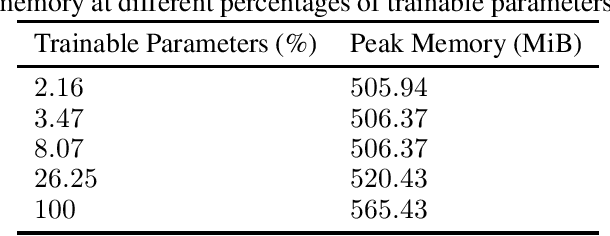
Abstract:Federated learning is used for decentralized training of machine learning models on a large number (millions) of edge mobile devices. It is challenging because mobile devices often have limited communication bandwidth and local computation resources. Therefore, improving the efficiency of federated learning is critical for scalability and usability. In this paper, we propose to leverage partially trainable neural networks, which freeze a portion of the model parameters during the entire training process, to reduce the communication cost with little implications on model performance. Through extensive experiments, we empirically show that Federated learning of Partially Trainable neural networks (FedPT) can result in superior communication-accuracy trade-offs, with up to $46\times$ reduction in communication cost, at a small accuracy cost. Our approach also enables faster training, with a smaller memory footprint, and better utility for strong differential privacy guarantees. The proposed FedPT method can be particularly interesting for pushing the limitations of overparameterization in on-device learning.
 Add to Chrome
Add to Chrome Add to Firefox
Add to Firefox Add to Edge
Add to Edge